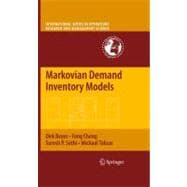
| List of Figures | p. ix |
| List of Tables | p. xi |
| Preface | p. xiii |
| Notation | p. xvii |
| Introduction | |
| Introduction | p. 3 |
| Characteristics of Inventory Systems | p. 3 |
| Brief Historical Overview of Inventory Theory | p. 5 |
| Examples of Markovian Demand Models | p. 12 |
| Contributions | p. 15 |
| Plan of the Book | p. 16 |
| Discounted Cost Models | |
| Discounted Cost Models with Backorders | p. 21 |
| Introduction | p. 21 |
| Review of the Related Literature | p. 22 |
| Formulation of the Model | p. 23 |
| Dynamic Programming and Optimal Feedback Policy | p. 26 |
| Optimality of (s, S)-type Ordering Policies | p. 31 |
| Nonstationary Infinite Horizon Problem | p. 33 |
| Cyclic Demand Model | p. 37 |
| Constrained Models | p. 37 |
| Concluding Remarks and Notes | p. 39 |
| Discounted Cost Models with Polynomially Growing Surplus Cost | p. 41 |
| Introduction | p. 41 |
| Formulation of the Model | p. 42 |
| Dynamic Programming and Optimal Feedback Policy | p. 44 |
| Nonstationary Discounted Infinite Horizon Problem | p. 49 |
| Optimality of (s, S)-type Ordering Policies | p. 55 |
| Stationary Infinite Horizon Problem | p. 57 |
| Concluding Remarks and Notes | p. 57 |
| Discounted Cost Models with Lost Sales | p. 59 |
| Introduction | p. 59 |
| Formulation of the Model | p. 60 |
| Optimality of (s,S)-type Ordering Policies | p. 63 |
| Extensions | p. 66 |
| Numerical Results | p. 69 |
| Concluding Remarks and Notes | p. 72 |
| Average Cost Models | |
| Average Cost Models with Backorders | p. 83 |
| Introduction | p. 83 |
| Formulation of the Model | p. 86 |
| Discounted Cost Model Results from Chapter 2 | p. 89 |
| Limiting Behavior as the Discount Factor Approaches 1 | p. 90 |
| Vanishing Discount Approach | p. 98 |
| Verification Theorem | p. 102 |
| Concluding Remarks and Notes | p. 106 |
| Average Cost Models with Polynomially Growing Surplus Cost | p. 107 |
| Formulation of the Problem | p. 107 |
| Behavior of the Discounted Cost Model with Respect to the Discount Factor | p. 109 |
| Vanishing Discount Approach | p. 116 |
| Verification Theorem | p. 125 |
| Concluding Remarks and Notes | p. 130 |
| Average Cost Models with Lost Sales | p. 133 |
| Introduction | p. 133 |
| Formulation of the Model | p. 133 |
| Discounted Cost Model Results from Chapter 4 | p. 137 |
| Limiting Behavior as the Discount Factor Approaches 1 | p. 138 |
| Vanishing Discount Approach | p. 142 |
| Verification Theorem | p. 145 |
| Concluding Remarks and Notes | p. 150 |
| Miscellaneous | |
| Models With Demand Influenced By Promotion | p. 153 |
| Introduction | p. 153 |
| Formulation of the Model | p. 155 |
| Assumptions and Preliminaries | p. 162 |
| Structural Results | p. 164 |
| Extensions | p. 170 |
| Numerical Results | p. 173 |
| Concluding Remarks and Notes | p. 174 |
| Vanishing Discount Approach Vs. Stationary Distribution Approach | p. 179 |
| Introduction | p. 179 |
| Statement of the Problem | p. 182 |
| Review of Iglehart (1963b) | p. 184 |
| An Example | p. 187 |
| Asymptotic Bounds on the Optimal Cost Function | p. 192 |
| Review of the Veinott and Wagner Paper | p. 195 |
| Existence of Minimizing Values of s and S | p. 197 |
| Stationary Distribution Approach versus Dynamic Programming and Vanishing Discount Approach | p. 203 |
| Concluding Remarks and Notes 206 | p. 206 |
| Conclusions and Open Research Problems | p. 211 |
| Appendices | |
| Analysis | p. 217 |
| Continuous Functions on Metric Spaces | p. 217 |
| Convergence of a Sequence of Functions | p. 219 |
| The Arzela-Ascoli Theorems | p. 220 |
| Linear Operators | p. 222 |
| Miscellany | p. 223 |
| Probability | p. 225 |
| Integrability | p. 225 |
| Conditional Expectation | p. 226 |
| Renewal Theorem | p. 227 |
| Renewal Reward Processes | p. 227 |
| Stochastic Dominance | p. 228 |
| Markov Chains | p. 229 |
| Convex, Quasi-Convex and K-Convex Functions | p. 233 |
| PF2 Density and Quasi-convex Functions | p. 233 |
| Convex and K-convex Functions | p. 234 |
| References | p. 241 |
| Copyright Permissions | p. 247 |
| Author Index | p. 249 |
| Subject Index | p. 251 |
| Table of Contents provided by Ingram. All Rights Reserved. |
The New copy of this book will include any supplemental materials advertised. Please check the title of the book to determine if it should include any access cards, study guides, lab manuals, CDs, etc.
The Used, Rental and eBook copies of this book are not guaranteed to include any supplemental materials. Typically, only the book itself is included. This is true even if the title states it includes any access cards, study guides, lab manuals, CDs, etc.